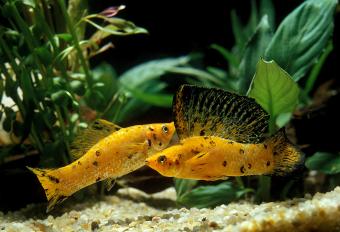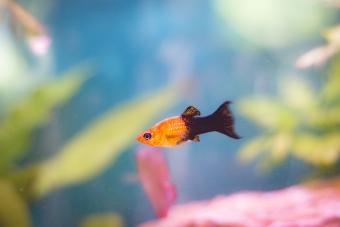
Goldfish are fairly hardy fish, and most will live for a long time if you care for them properly. Even if you look after your aquatic pet like it's the most precious thing in the world, knowing how to identify goldfish disease symptoms will help to ensure your fish gets the right treatment before it's too late. From white spots on your goldfish to fin rot, these are the 12 most common goldfish diseases you should be familiar with.
Similar Symptoms Can Be Confusing
Most symptoms of disease you will observe in goldfish involve discoloration or a change in the appearance of their fins and body. It isn't always clear what you're looking at, at least if you don't have experience identifying these conditions.
Colored spots, such as white, red, or black spots on goldfish, can indicate the presence of a disease. Parasites are often the cause of a change in your fish's appearance. You may also observe changes in how they swim or their activity level. Most of the time, you'll have to put the symptoms together to come up with a tentative diagnosis. Use the listed symptoms to help identify which illness might be plaguing your goldfish.
1. Ich
- Small white spots indicate your goldfish has ich.
- The white spots are more obvious on darker colored fish, but you will eventually see them on lighter fish as the disease worsens.
- Lack of eating accompanied by ich can also lead to your fish swimming or floating upside down.
- If the fins appear "clamped," this means they may have ich, flukes, lice, or velvet.
- Goldfish with ich are lethargic, will stop eating, and often have trouble breathing.
Ich (sometimes spelled ick), also known as white spot disease, appears as white spots on the side of the fish. These spots are about the size of grains of salt, and they are actually parasites called Ichthyophthirius multifiliis. Ich is fast-spreading and very lethal to goldfish if left untreated.
2. Anchor Worms
- Red spots on your fish's body are probably parasites such as lice or anchor worms.
- If you notice what appears like tiny "threads" hanging from the fish, this is a sign of anchor worms.
- An infected fish may shake their head vigorously to rid themselves of the parasite.
Anchor worm is a parasite that is most commonly found in fish that are kept outside in ponds, as many koi and large goldfish often are. Anchor worm is not really a worm, but rather the feeding stage of a copepod called Lernaea.
After mating, the female anchor worm burrows into the flesh of the goldfish and eventually transforms into a wormlike form. A part of the worm usually sticks out from the fish's body, resembling a reddish thread. It is usually found near the fins. If left untreated, anchor worm eventually destroys the gill and muscle tissue around the affected area.
3. Fin Rot
- Black spots on your goldfish might occur after a case of fin rot or it can indicate your tank has too much ammonia.
- Red streaks on the fins that eventually become white indicate a condition called fin rot or tail rot.
- If you notice that your fish's fins no longer look bright and flowing, but instead appear almost broken or torn, your fish is suffering from fin rot.
- Fish that have an extensive case of fin rot will also have similar problems swimming correctly, so if you observe this behavior accompanied by ragged fins, look for a treatment for fin rot.
Fin rot is caused by a number of things, from injury to disease. It can also be the result of either a primary or secondary infection. If the tail fin is very ragged looking, the fin rot is normally the result of a bacterial infection.
On the other hand, if the tail is rotting away evenly, then it is the sign of a fungal infection. If the fin takes on a whitish margin, a bacterial infection has taken hold and if left untreated, it will eventually enter the body of the fish. As long as the fish is treated before the infection reaches its body, the tail fin will grow back.
4. Velvet Disease
-
Tiny yellowish spots that almost look like powder is a characteristic symptom of velvet disease in goldfish.
-
The scales will look textured, like velvet.
-
If your goldfish stops eating, this can be a symptom of several diseases such as ich and velvet.
-
The fish's fins will be clamped to their body.
Velvet disease is caused by a parasite called Oodinium, and it results in a golden, velvet-like coating all over the fish's body. It is often difficult to identify in goldfish because the coating is almost the same color as the fish. Treatment for velvet is similar to that of ich.
5. Dropsy
- Signs of dropsy include bloated eyes, a swollen body, and protruding scales.
- If the fish's color seems pale and washed out all over, this is a symptom of dropsy.
- Swollen eyes accompanied by a bloated body are a sign of dropsy.
- A swollen belly accompanied by lethargy can also be a sign of constipation, particularly if the fish has not defecated in several days.
- If your fish appears to have trouble swimming, such as moving with the body plane on an angle, floating almost upside down, or with their heads pointing down, your fish has swim bladder disease.
Dropsy is one of the rarer goldfish diseases. If the fish's belly appears bloated and the fins are sticking out from his body, this means they have dropsy. This is also known as "pineconing" and gets its name from viewing the fish from the top. The body looks like a pinecone because of the bloat and the scales appearing somewhat separated from the fish's belly and sides.While treatments are available, a full recovery is virtually impossible. This condition is usually a result of organ failure due to cancer or extremely poor environmental conditions.
6. Fish Lice
- Another parasite observable to the eye is lice, whose tiny bodies you can see moving by the goldfish's eyes, gills, and fins.
- Signs of fish lice include disc-shaped parasites noticeable on the skin of the fish and ulcers on the body of the fish.
Fish lice are very rare, especially in goldfish, but that doesn't mean it doesn't still happen. The lice attach to the body of the goldfish and feed on their tissues. The treatment for fish lice is the same as for anchor worms.
Rubbing against the tank and decorations most likely means the fish either has ich, flukes, lice, or anchor worms. This is also known as "flashing" because it may be accompanied by rapid movements.
7. Black Spot Disease
- Black spots along the fish's body and fins.
Black spot disease isn't really a disease. Rather, it is a natural reaction by the goldfish when their water has too high a concentration of ammonia, and is sometimes called ammonia burn. When this happens, black spots will form along the side or near the back side of the fish. This usually happens most often with goldfish and koi kept outside.
8. Chilodonella
- Typical symptoms of chilodonella include clamped fins, lethargy, difficulty breathing, and loss of appetite.
Chilodonella is difficult to determine in goldfish because the disease has very few visible signs during the initial stages. In most cases, by the time the disease is detected, severe tissue damage has already occurred.
9. Hole-in-the-Head Disease
- Goldfish with this disease will first show a small hole or indent on their head.
- The spot will erupt into a larger hole.
- The fish's energy will be low, and they will appear depressed.
Hole-in-the-head disease will usually start off as small sores on the head, usually around the eyes. Eventually, these sores erupt into tubular formations filled with cream-colored mucous.
10. Pop Eye
- The symptoms of pop eye include very inflamed eye sockets, and protruding eyes.
- In some cases, you may notice a hazy film over the goldfish's eyes.
- The fish's fins will be clamped (where the caudal and tail fin look like a hand fan that isn't open, and instead is scrunched together).
- Their energy will appear low.
Pop eye is a condition that's typically caused either by parasites or very poor water conditions. Both eyes will be affected and protrude with pop eye.
The technical term for pop eye is exophthalmia.
11. Slime Disease
- The goldfish will have a greyish/white film over their body.
- The goldfish will also look as if it is trying to scratch itself against the tank or other objects inside the tank.
Slime disease is usually a result of another disease like chilodonella or parasites. Its symptoms include a grayish coating on the fins or body. The film will rapidly accumulate on the fish's body and impact their quality of life. You'll need to treat the fish with water changes and medication for slime disease.
12. Flukes
-
Sores and ulcerations on the fish's body are also a sign that they have flukes or it could be hole-in-the-head disease.
-
Pale or white gills means a parasitic infection such as flukes.
- A slimy, milky coat on the fish indicates a fluke infection or anchor worms.
-
If you notice a fish's gills moving rapidly or irregularly, this could indicate ich, flukes, or constipation.
Flukes are microscopic parasites that embed themselves in the gills of the goldfish and cause them to become red and swollen. The fish will also spend more time near the surface of the water because it will have difficulty breathing as a result of this disease.
Treating Goldfish Diseases
When treating goldfish diseases based on your fish's symptoms, cleaning and sanitizing the tank is one of the most important things you can do. Remove the affected goldfish and put it in an isolation tank. Thoroughly clean and sanitize the tank and refill it with fresh, clean water.
Finally, treat the water with stabilizers and wait for the environment and water chemistry to equalize before re-introducing your fish. In the meantime, ask your local aquarium shop to help you diagnose your pet's illness by the symptoms it exhibits, treat them with the medication they recommend, and maintain the stability of his environment in order for your goldfish to have the best chance at recovery.







